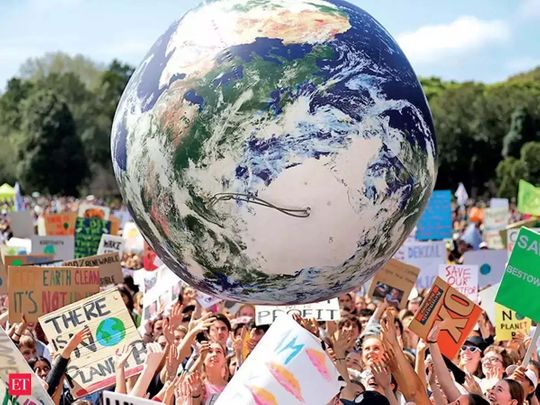
Journalists can have dark senses of humour — often a way of dealing with the stress of deadlines, making instant decisions, putting big issues and news stories, which are hard to grasp or comprehend in the big picture, into a few hundred words that resonate with readers on a page or a screen.
Nowadays, we are all critically aware of just how fragile our environment is. The ice caps are melting; sea waters rising; oceans becoming warmer; weather events becomes more extreme and happening with alarming recurrence; monthly reminders that the previous month was the hottest on record.
We know now of phrases like “carbon footprint”, “greenhouse emissions”, “air quality particulates” — they are the language of our time as we confront the greatest challenge now for ourselves and future generations in the stewardship of this planet we all share.
The reality too is that for Europe, Kyoto was a game changer. The idea was pretty simple — big nations that had historically produced most of the greenhouse gases should take the lead in slowing climate change.
And when historians and authors look back at this time, they will point to the Kyoto Protocol as the starting point in this challenge that will make or break us. Who would have known then, 15 years ago this week, that this obscure agreement signed in what had been the seat of government for the Japanese Imperial Court would change our lives and those of future generations.
I remember sitting in news meetings of senior editors in Toronto, and trying to make sense of that gathering. Searching for a “lead” — the main news story on the front page that is supposed to make you, dear reader, buy the paper.
“What about Kyoto?” I offered.
“Kyoto is Japanese for turn the page,” came the reply. Readers wouldn’t be interested. Something else was more important than the protocol that took effect in February 2005.
The reality is that Kyoto was our first real attempt to change our environment, take responsibility for the greenhouse gases heating up our planet, a protocol that would first impose binging limits on 38 of the world’s most polluting nations. And when it came into effect, more than 140 countries signed on too.
Game changer
The reality too is that for Europe, Kyoto was a game changer. The idea was pretty simple — big nations that had historically produced most of the greenhouse gases should take the lead in slowing climate change. The European Community — the political precursor to the European Union — embraced it fully, even after the United States and Canada withdrew by 2011.
Germany alone cut its emissions by 23 per cent while across the EU, the average cut was 19 per cent. That would be impressive if not for the fact that globally, emissions rose by almost 40 per cent. That’s one step forward, two steps back at a time when time itself is the most precious commodity in this race to save our planet from ourselves.
The protocol had its genesis in the climate summit in 1992 in Rio de Janeiro, and it took a good 15 years to convince governments that their economies were ultimately to blame for the worsening state of the environment. Looking back, those 15 years seem time wasted.
Kyoto too cast in stone the notion of carbon trading and taxes on emitting carbon dioxide into the atmosphere. In Europe, there is a price for producing CO2 — In Sweden, it’s €114 (Dh452 per tonne), €15 in Spain, €44.60 in France, €20.34 in the United Kingdom. Every EU nation is required to do its part and, there’s every chance now that EU environment ministers and the EU Commission will unify those rate to reinforce the principal that polluters pay.
Kyoto principles
Thanks to the principles of Kyoto, it is now illegal to drive diesel cars or will cost you a pretty penny to do so in a growing number of European cities.
Before Kyoto came into effect, the notion of moving Europe’s industrialised nations — together they are the third-largest economic trading bloc in the world — to renewable energy was the policy of hard-left green activists. Today, it is mainstream thinking and policy across the EU.
Kyoto set the ambitious target of having 20 per cent of energy needs met by renewable sources by 2020. The EU average has exceeded those targets if only because Nordic nations are leading the way while others, such as Ireland, Belgium, Poland, Hungary, Slovakia and Malta remain laggards — facing punitive measures if they don’t put their house in order by the end of the year.
Slovenia, Romania, Lithuania, Latvia, Sweden, Finland, Portugal, Austria and Estonia have met that target by the end of 2018 according to Eurostat, the EU statistical agency.
But Kyoto wasn’t perfect. Developing countries didn’t have to commit to those greenhouse emission targets — and where would we be now in the fight for climate action if the emerging economies then of China, India and Indonesia had to limit their emissions as their economies expanded massively. That is a question that can only be answered in the fullness of time: But time is a dwindling resource.
If there is a lesson from Kyoto, it is that international agreements can work. It’s just that that lesson never seems to be fully learnt.









